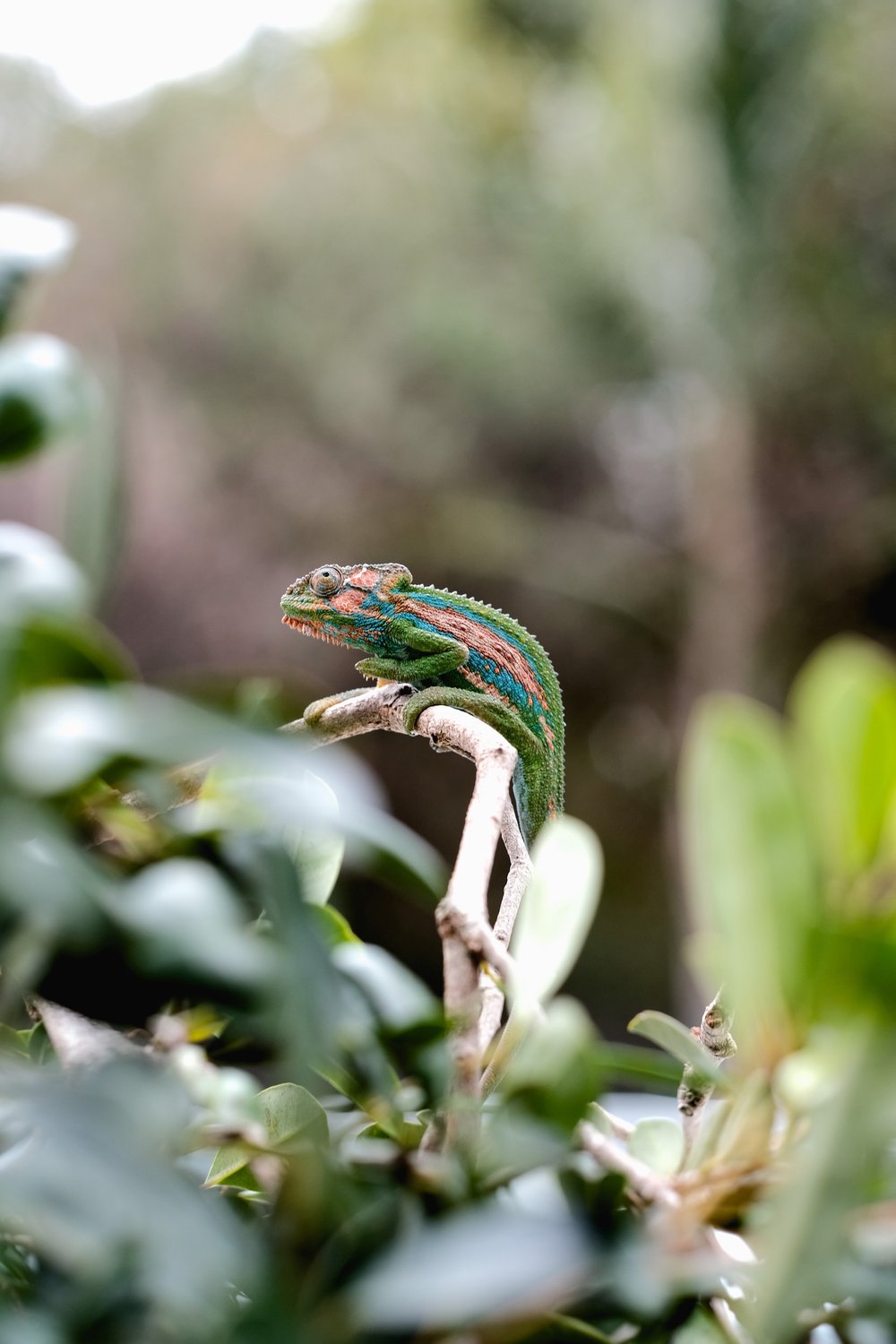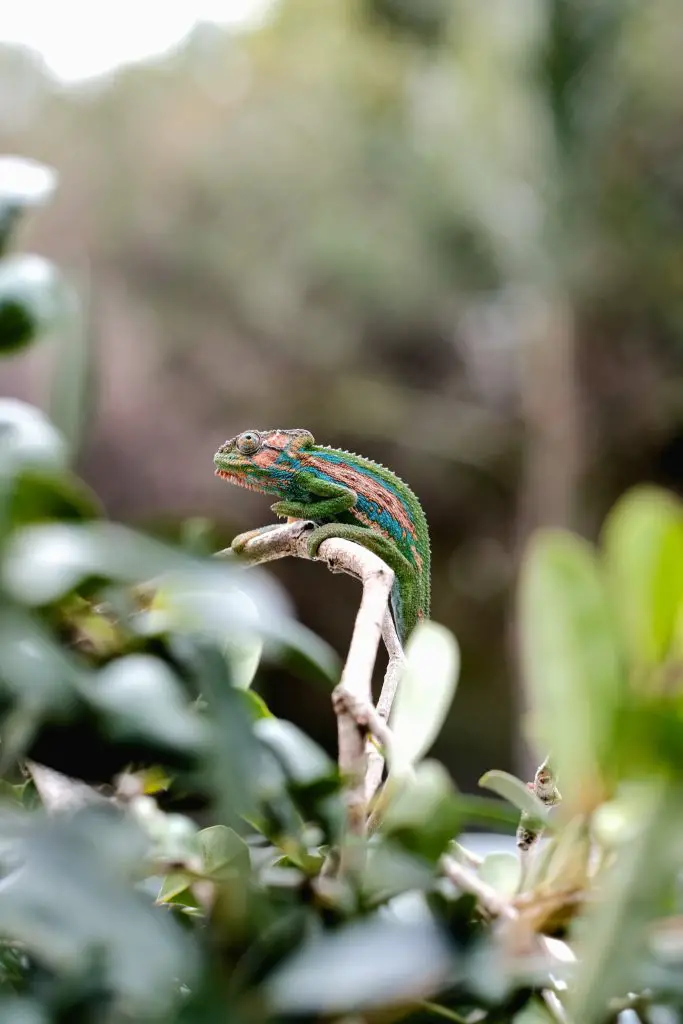If you’re a chameleon owner, you know how important it is to provide a safe and healthy environment for your pet. One way to do this is by incorporating live plants into their habitat. Not only do plants provide oxygen and humidity, but they also offer a natural and stimulating environment for your chameleon to explore. However, not all plants are safe for your chameleon to consume. In this article, we will discuss 10 safe and non-toxic plants that are perfect for your chameleon’s habitat.
Chameleons love to climb and explore, but it’s important to keep them safe by choosing non-toxic plants for their habitat. Here are 10 safe and non-toxic plants for chameleons: hibiscus, ficus, bromeliads, pothos, spider plants, orchids, dracaena, wandering jew, snake plant, and money tree. These plants will not only enhance your chameleon’s environment, but also provide them with a sense of security and comfort.

10 Safe & Non-toxic Plants for Chameleons
Chameleons are fascinating creatures that require a lot of attention and care. One of the essential aspects of chameleon care is providing them with a suitable environment that mimics their natural habitat. A significant part of creating a healthy habitat is selecting the right plants. In this article, we will list ten safe and non-toxic plants for chameleons.
1. Hibiscus
Hibiscus is a popular choice for chameleon owners due to its colorful flowers and non-toxic leaves. These plants thrive in warm and humid environments, making them a perfect addition to a chameleon’s terrarium. Hibiscus is also incredibly versatile, and you can easily train it to grow in various shapes and sizes.
When selecting a hibiscus plant for your chameleon, make sure to choose one with bright, vibrant flowers. The flowers are not only pleasing to the eye, but they also provide a source of hydration for your chameleon. Additionally, the leaves of the hibiscus plant are edible for chameleons and provide a healthy source of nutrition.
2. Pothos
Pothos is an excellent choice for chameleon owners who are new to plant care. These plants are easy to care for and can thrive in a variety of environments. Pothos plants have long vines that are perfect for climbing, providing a naturalistic environment for your chameleon.
One of the benefits of pothos plants is that they are incredibly versatile. You can train them to grow in different shapes and sizes, making them perfect for a chameleon’s terrarium. Additionally, pothos plants are non-toxic and safe for chameleons to consume.
3. Ficus Benjamina
Ficus Benjamina, also known as the weeping fig, is a popular choice among chameleon owners. These plants have long, drooping leaves that provide a naturalistic environment for your chameleon to climb and explore. Additionally, ficus benjamina plants are non-toxic and safe for chameleons to consume.
When selecting a ficus benjamina plant for your chameleon, make sure to choose one with dense foliage. The dense foliage provides a source of shade and protection for your chameleon. However, keep in mind that ficus benjamina plants require a lot of light, so make sure to place them in a well-lit area.
4. Schefflera
Schefflera plants, also known as umbrella plants, are a popular choice among chameleon owners. These plants have large, umbrella-like leaves that provide a naturalistic environment for your chameleon. Additionally, schefflera plants are non-toxic and safe for chameleons to consume.
When selecting a schefflera plant for your chameleon, make sure to choose one with dense foliage. The dense foliage provides a source of shade and protection for your chameleon. Additionally, schefflera plants require a lot of light, so make sure to place them in a well-lit area.
5. Spider Plant
Spider plants are a popular choice among chameleon owners due to their non-toxic leaves and easy care requirements. These plants have long, spiky leaves that provide a naturalistic environment for your chameleon. Additionally, spider plants are incredibly hardy and can thrive in a variety of environments.
When selecting a spider plant for your chameleon, make sure to choose one with bright, healthy leaves. The bright leaves provide a source of hydration for your chameleon. Additionally, spider plants are known to purify the air, making them an excellent choice for a chameleon’s terrarium.
6. Dracaena
Dracaena plants, also known as corn plants, are a popular choice among chameleon owners. These plants have long, striped leaves that provide a naturalistic environment for your chameleon. Additionally, dracaena plants are non-toxic and safe for chameleons to consume.
When selecting a dracaena plant for your chameleon, make sure to choose one with dense foliage. The dense foliage provides a source of shade and protection for your chameleon. Additionally, dracaena plants are incredibly hardy and can thrive in a variety of environments.
7. Bromeliads
Bromeliads are a popular choice among chameleon owners due to their colorful flowers and non-toxic leaves. These plants thrive in warm and humid environments, making them a perfect addition to a chameleon’s terrarium. Additionally, bromeliads are incredibly versatile, and you can easily train them to grow in various shapes and sizes.
When selecting a bromeliad plant for your chameleon, make sure to choose one with bright, vibrant flowers. The flowers are not only pleasing to the eye, but they also provide a source of hydration for your chameleon. Additionally, bromeliads are known to purify the air, making them an excellent choice for a chameleon’s terrarium.
8. Aloe Vera
Aloe vera plants are a popular choice among chameleon owners due to their medicinal properties and non-toxic leaves. These plants have long, spiky leaves that provide a naturalistic environment for your chameleon. Additionally, aloe vera plants are incredibly hardy and can thrive in a variety of environments.
When selecting an aloe vera plant for your chameleon, make sure to choose one with healthy leaves. The leaves of the aloe vera plant contain a gel that is known to have medicinal properties. Additionally, aloe vera plants require a lot of light, so make sure to place them in a well-lit area.
9. African Violet
African violet plants are a popular choice among chameleon owners due to their colorful flowers and non-toxic leaves. These plants have small, delicate leaves that provide a naturalistic environment for your chameleon. Additionally, African violet plants are incredibly hardy and can thrive in a variety of environments.
When selecting an African violet plant for your chameleon, make sure to choose one with bright, vibrant flowers. The flowers are not only pleasing to the eye, but they also provide a source of hydration for your chameleon. Additionally, African violet plants are known to purify the air, making them an excellent choice for a chameleon’s terrarium.
10. Tillandsia
Tillandsia plants, also known as air plants, are a popular choice among chameleon owners. These plants do not require soil to grow and can be attached to branches or other structures in a chameleon’s terrarium. Additionally, Tillandsia plants are non-toxic and safe for chameleons to consume.
When selecting a Tillandsia plant for your chameleon, make sure to choose one with healthy leaves. The leaves of the Tillandsia plant absorb moisture from the air, making them an excellent source of hydration for your chameleon. Additionally, Tillandsia plants require minimal care and are incredibly hardy.
In conclusion, selecting the right plants for your chameleon’s terrarium is essential for their health and well-being. The ten plants listed above are safe, non-toxic, and provide a naturalistic environment for your chameleon to thrive. Make sure to research the care requirements for each plant and choose the ones that best suit your chameleon’s needs.
Frequently Asked Questions
Chameleons are fascinating creatures that require attention and care to thrive in captivity. One of the essential aspects of keeping chameleons is providing them with a suitable environment, including plants. Here are the answers to some frequently asked questions about safe and non-toxic plants for chameleons.
What are the benefits of having live plants in a chameleon’s enclosure?
Live plants provide many benefits to a chameleon’s enclosure, including improving air quality, regulating humidity levels, and providing hiding spots. Plants also help to create a natural and aesthetically pleasing environment for your chameleon to live in. Additionally, some plants have medicinal properties that can benefit your chameleon’s health.
However, you must choose the right plants to avoid exposing your pet to toxic substances. Always research the plants you plan to use before adding them to your chameleon’s enclosure.
What are some safe and non-toxic plants for chameleons?
There are several safe and non-toxic plants that you can add to your chameleon’s enclosure, including pothos, hibiscus, ficus, schefflera, and dracaena. These plants are safe for chameleons and provide a range of benefits, including improving air quality and creating a natural environment. However, it’s essential to ensure that the plants you choose are free from any pesticides or chemicals that could harm your chameleon.
Additionally, you should avoid using plants that are toxic to chameleons, such as ivy, oleander, and philodendron. Always research any plants before adding them to your chameleon’s enclosure.
How should I care for the plants in my chameleon’s enclosure?
Caring for the plants in your chameleon’s enclosure is essential to ensure they remain healthy and provide the benefits they are meant to. You should ensure that the plants have adequate light, water, and nutrients. You may need to trim or prune the plants to prevent them from overgrowing and taking over the enclosure.
If you notice any signs of damage or disease in the plants, such as wilting or discoloration, you should remove them from the enclosure immediately. You should also monitor your chameleon’s behavior around the plants to ensure they are not consuming or damaging them.
Can I use artificial plants instead of live plants in my chameleon’s enclosure?
While artificial plants may be easier to care for than live plants, they do not provide the same benefits to your chameleon’s enclosure. Artificial plants do not improve air quality or regulate humidity levels, and they do not provide hiding spots or a natural environment. Additionally, some chameleons may try to eat artificial plants, which can be harmful to their health.
If you are unable to care for live plants, you may want to consider using other natural materials, such as branches, rocks, or soil, to create a natural environment for your chameleon.
What should I do if my chameleon eats a toxic plant?
If you suspect that your chameleon has eaten a toxic plant, you should seek veterinary care immediately. The symptoms of plant toxicity can vary depending on the plant ingested, but they may include vomiting, diarrhea, lethargy, or seizures. Your veterinarian can provide treatment to minimize the effects of the toxin and prevent further harm to your chameleon.
In the future, be sure to research any plants before adding them to your chameleon’s enclosure and remove any plants that show signs of damage or disease immediately.
In conclusion, selecting the right plants for your chameleon’s terrarium can be a daunting task. However, by choosing safe and non-toxic plants, you can create a beautiful and healthy environment for your pet.
We hope our list of 10 safe and non-toxic plants for chameleons has helped you in making the right decision for your pet’s well-being. These plants not only add beauty to your pet’s habitat, but also provide a natural and healthy source of nutrition for your chameleon.
Remember, the health and safety of your pet should always be your top priority. By carefully selecting the plants in your chameleon’s habitat, you can ensure that your pet thrives in a safe and healthy environment.


